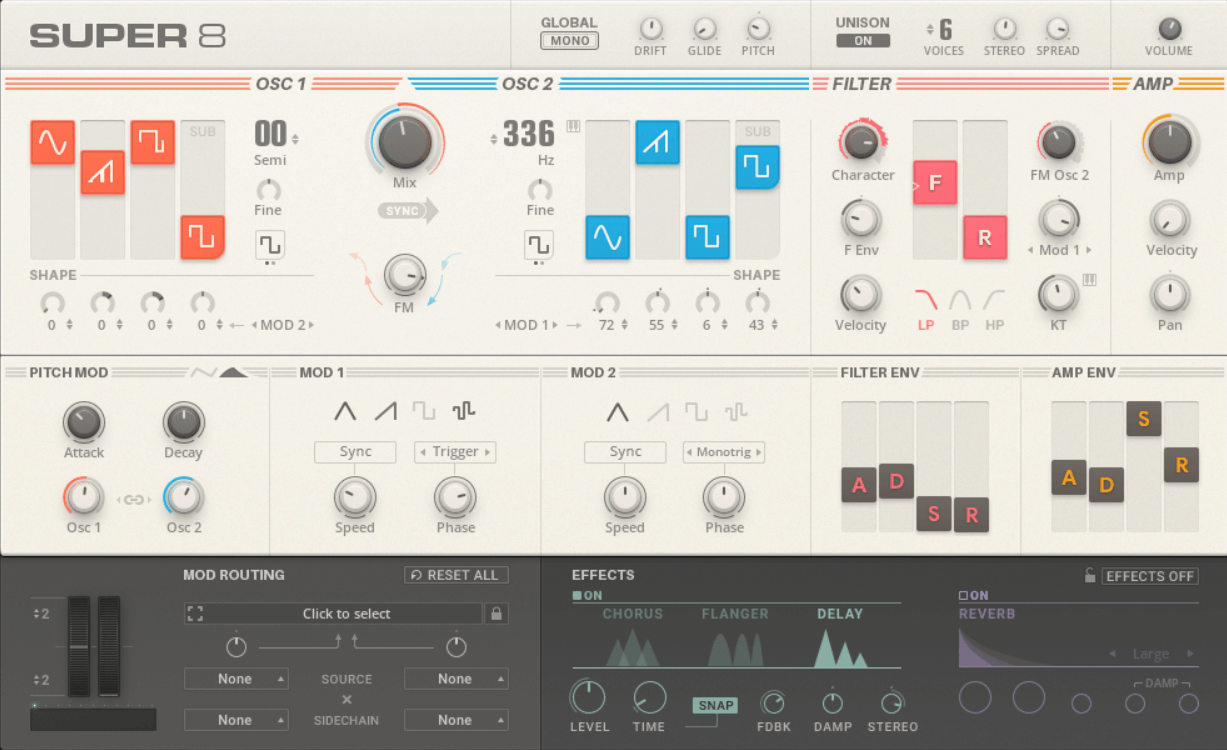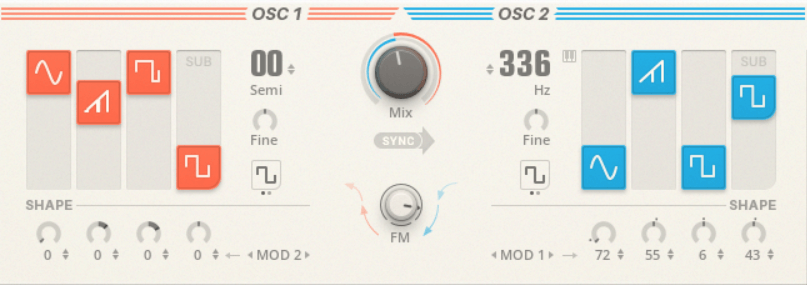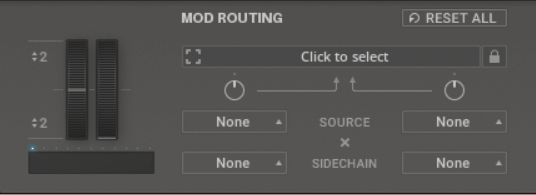Review: Native Instruments Super 8 – a simple layout capable of big, complex sounds
Super 8 is a polyphonic subtractive synthesizer with a streamlined workflow that’s capable of super-expressive analog synth sounds packed with character.
Electronic music producers with a keen ear for big leads, analog basses, and lush pads found in Techno, DnB, Trance, and more including alternative and experimental styles will find Super 8 a joy to work with. Not only is its user interface very pretty, but it’s also designed to be easy to use while driving creative experimentation. And that, in a nutshell, is why it’s a fantastic choice for music producers and sound designers of all experiences.
Native Instruments modeled Super 8 on vintage polysynth sounds, and it brings these to life with 8 expressive voices. And Super 8 offers over 550 presets that demonstrate the contrast in sounds the synth is capable of making. Big room leads, subtle sound effects, damp sonic environments, and more await you in Super 8.
A simple interface that’s easy to use
Software synths like Serum, Massive, Palindrome, and other popular synthesizers offer a plethora of tools – so much so that it’s overwhelming for newcomers. While Super 8 offers a number of flexible controls, it also offers a simple workflow with no additional tabs – everything is in one place.

So if you’re a newcomer to electronic music and sound design then a softsynth with this workflow lets you easily learn how synthesizers work. In fact, the clear labeling of each module across the interface demonstrates the subtractive signal flow before you even play a sound.
Two almost identical oscillators offer 3 waveform generators (sine, sawtooth, and square) that you can blend together with level faders, and both have another generator that you can switch between a square wave sub or a noise engine. And below these faders are simple modulable pot-style knobs that morph the waveform shapes and adjust the pulse width of the square waves, thereby adjusting the harmonic content of the oscillators.
Sure, Super 8 may appear to be pretty limited compared to Serum with its countless wavetables. But the simple morphing controls and individual waveform level faders allow you to blend harmonic characteristics and create incredibly vibrant sounds before you add more voices to the sound.
In fact, Super 8 can produce luscious tones with 2 voices alone and bring the beautiful poly analog sound to life for heavy-hitting lead and spacious pads. Add more voices in the Unison tab at the top of the synth where three sub-sections for global controls sit, including output level, tuning, and playing mode controls, and then a Unison tab.
Frequency and tuning
The oscillators alone make it easy to explore sonic opportunities. Add more grit with the frequency modulation knob where the frequency of oscillator 2 modulates oscillator 1 for crunchy and metallic textures.

Oscillator 2 even has the sweet addition of simple key tracking settings (the small piano button to the right of the frequency). Switch KT on and the oscillator pitch is determined by semitones, but switch it off and set the frequency in Hz as shown above. The second oscillator can produce specific tones within the frequency spectrum as a result and the output is magnificent. Especially with a bit of frequency modulation!
Modulable subtractive filtering
Three filter modes – low-pass, high-pass, and band-pass – give you a few options for sculpting a sound out of the raw oscillator frequencies. Then a simple fader allows you to determine the filter cut-off (which you can modulate with a dedicated tab), and an identical fader to the right lets you dial in a clean resonance.

Aside from these universal filter controls, a pot-style knob for dialing in frequency modulation from oscillator 2 thickens the texture of the filter. Then add expression with key tracking, whereby Super 8’s “Key Tracking Chromatic” (the piano button) tells the filter frequency to follow your MIDI keys presses whilst the Key Tracking pot knob influences the filter rather than applying hard tracking.
Add drive to the filter with the dedicated “Character” knob, further shape the filter with a filter ADSR envelope found in the synths’ modulation section, and make the filter follow the velocity of each keypress if you want to. All in all, the filter is one of the most expressive modules in Super 8. Its easy layout gives you a number of options for adding character to your sound with no hassle.
Extensive modulation
Super 8 offers a lot of flexible modulation options with an amplitude envelope, a filter envelope, and two LFOs with fixed waveforms, in addition to oscillator pitch modulators.
Moreover, Super 8 utilizes an intuitive modulation routing panel that allows you to route any of its modulators to any parameter. Though it’s not quite the same as a modulation matrix, it does give you full control over modulation in the synth.
You can choose the parameter you want to modulate with the Destination tab by selecting the knob or slider you want to modulate, and then choose the modulation source (LFOs, Amp & Filter Envelopes, Touchstrip, and so on), and use the Depth controls to determine the intensity of the modulation. On top of that, you can add sidechain routings (sitting beneath the mod source) and adjust the depth of continuously modulated parameters with static control.

Users new to synthesis and modulation routing will find pleasure in this simplicity. I remember when I first started out with Serum with no prior experience in synthesis – the swathe of options overwhelmed me. Its mod matrix made little sense, and the world of flexibility that Serum offers ended up frustrating me. But the simplicity of the modulation that Super 8 gives you makes it easy to simply have fun.
The modulators
Furthermore, Super 8’s two LFO modules are identical in functionality. Select the LFO waveform or multiple waveforms for complex modulation, and choose between four modulation modes – Monophonic (MONO), Polyphonic (POLY), Trigger (TRIG) & Mono Trigger (MONOTRIG) – and determine how the modulators will trigger. Then use the speed control and set the modulation rate, or use the Sync button to synchronize the rate to the tempo of your host DAW/Reaktor.

I think the POLY & TRIG are the most expressive of the bunch. The polyphonic mode gives each voice you set in the Unison tab a dedicated LFO while Trigger creates a new LFO with every key press. On the other hand, Mono Trigger mode works perfectly on all parameters with gliding 808 basses as it triggers the LFO on the first note press and doesn’t trigger again until all keys are released.
Additionally, a dedicated pitch modulation module gives you the choice of an LFO or Envelope for pitch modulation of either or both oscillators. You can choose between the modes in the top right of the module, and the mode you choose determines whether the modulation repeats or triggers once. And better yet, a Link control sits between the two oscillator knobs and lets you synchronize the modulation across both oscillators!
These simple modulation modules and extensive routing options add so much more depth to any sound that leaves Super 8. Even a subtle amount of modulation on the pitch of one oscillator packs a punch!
Effects
Lastly, the effects section in Super 8 presents 2 effects slots with a dedicated reverb occupying the second. The first slot contains three options – a chorus, a flanger, and a delay. Each of the three effects in slot 1 has unique controls that activate when the effect in question is enabled. While the chorus only has a Wet & Speed control, the flanger and delay effects have a few more that give you more creative control over how the effects change your sound.

Conclusion
Despite its lack of visual cues compared to other synth powerhouses I’ve mentioned, those new to sound design that spends a few hours with Super 8 and its manual will quickly learn the basics of synthesis. And better yet, you don’t need to use Super 8 for more than 5 minutes and get a good sound! Starting small with an easy-to-use synth like Super 8 will teach you everything you need to know before you jump in with more complex synths.
Of course, Super 8’s parameters are all mapped to both the A &S series of Native Instruments MIDI controllers, so I recommend checking those out if you want to get away from your mouse & computer keyboard. Super 8’s UI even hosts a touch strip and pitch and modulation wheels that emulate those on the controllers – and you can use them as modulation sources too! And you can map every other parameter of Super 8 to knobs and faders on your hardware too.
I think the beauty of Super 8 lies in its simplicity. Every feature is easy to find with no hidden tabs, and every control adds something new to the sound. Ultimately, Super 8 is capable of creating huge sounds with thick textures, and it can deliver unique timbres with a bit of Unison.
Consequently, Super 8 deserves its place as a classic analog-modeled poly softsynth. Modern musical styles call for a range of tools to keep driving the creativity machine, and Super 8 definitely deserves to be one of them.
